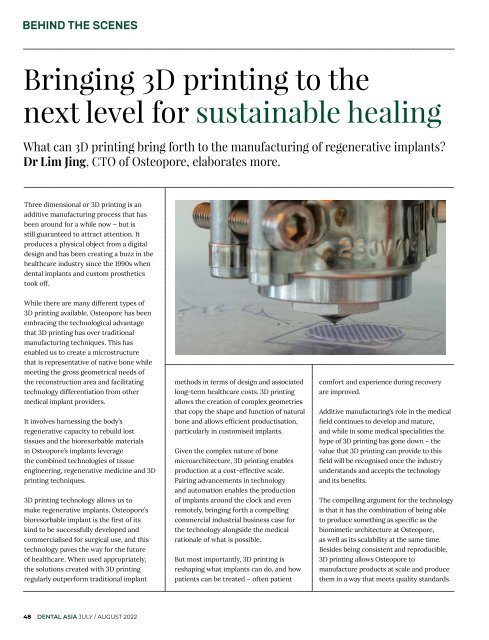Dental Asia July/August 2022
For more than two decades, Dental Asia is the premium journal in linking dental innovators and manufacturers to its rightful audience. We devote ourselves in showcasing the latest dental technology and share evidence-based clinical philosophies to serve as an educational platform to dental professionals. Our combined portfolio of print and digital media also allows us to reach a wider market and secure our position as the leading dental media in the Asia Pacific region while facilitating global interactions among our readers.
For more than two decades, Dental Asia is the premium journal in linking dental innovators and manufacturers to its rightful audience. We devote ourselves in showcasing the latest dental technology and share evidence-based clinical philosophies to serve as an educational platform to dental professionals. Our combined portfolio of print and digital media also allows us to reach a wider market and secure our position as the leading dental media in the Asia Pacific region while facilitating global interactions among our readers.
You also want an ePaper? Increase the reach of your titles
YUMPU automatically turns print PDFs into web optimized ePapers that Google loves.
BEHIND THE SCENES<br />
Bringing 3D printing to the<br />
next level for sustainable healing<br />
What can 3D printing bring forth to the manufacturing of regenerative implants?<br />
Dr Lim Jing, CTO of Osteopore, elaborates more.<br />
Three dimensional or 3D printing is an<br />
additive manufacturing process that has<br />
been around for a while now – but is<br />
still guaranteed to attract attention. It<br />
produces a physical object from a digital<br />
design and has been creating a buzz in the<br />
healthcare industry since the 1990s when<br />
dental implants and custom prosthetics<br />
took off.<br />
While there are many different types of<br />
3D printing available, Osteopore has been<br />
embracing the technological advantage<br />
that 3D printing has over traditional<br />
manufacturing techniques. This has<br />
enabled us to create a microstructure<br />
that is representative of native bone while<br />
meeting the gross geometrical needs of<br />
the reconstruction area and facilitating<br />
technology differentiation from other<br />
medical implant providers.<br />
It involves harnessing the body’s<br />
regenerative capacity to rebuild lost<br />
tissues and the bioresorbable materials<br />
in Osteopore’s implants leverage<br />
the combined technologies of tissue<br />
engineering, regenerative medicine and 3D<br />
printing techniques.<br />
3D printing technology allows us to<br />
make regenerative implants. Osteopore’s<br />
bioresorbable implant is the first of its<br />
kind to be successfully developed and<br />
commercialised for surgical use, and this<br />
technology paves the way for the future<br />
of healthcare. When used appropriately,<br />
the solutions created with 3D printing<br />
regularly outperform traditional implant<br />
methods in terms of design and associated<br />
long-term healthcare costs. 3D printing<br />
allows the creation of complex geometries<br />
that copy the shape and function of natural<br />
bone and allows efficient productisation,<br />
particularly in customised implants.<br />
Given the complex nature of bone<br />
microarchitecture, 3D printing enables<br />
production at a cost-effective scale.<br />
Pairing advancements in technology<br />
and automation enables the production<br />
of implants around the clock and even<br />
remotely, bringing forth a compelling<br />
commercial industrial business case for<br />
the technology alongside the medical<br />
rationale of what is possible.<br />
But most importantly, 3D printing is<br />
reshaping what implants can do, and how<br />
patients can be treated – often patient<br />
comfort and experience during recovery<br />
are improved.<br />
Additive manufacturing’s role in the medical<br />
field continues to develop and mature,<br />
and while in some medical specialities the<br />
hype of 3D printing has gone down – the<br />
value that 3D printing can provide to this<br />
field will be recognised once the industry<br />
understands and accepts the technology<br />
and its benefits.<br />
The compelling argument for the technology<br />
is that it has the combination of being able<br />
to produce something as specific as the<br />
biomimetic architecture at Osteopore,<br />
as well as its scalability at the same time.<br />
Besides being consistent and reproducible,<br />
3D printing allows Osteopore to<br />
manufacture products at scale and produce<br />
them in a way that meets quality standards.<br />
48 DENTAL ASIA JULY / AUGUST <strong>2022</strong>


















